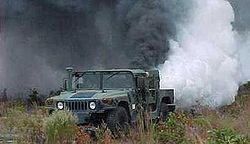
A smoke screen is smoke released to mask the movement or location of military units such as infantry, tanks, aircraft or ships.
Smoke screens are commonly deployed either by a canister (such as a grenade) or generated by a vehicle (such as a tank or a warship).
Whereas smoke screens were originally used to hide movement from enemies' line of sight, modern technology means that they are now also available in new forms; they can screen in the infrared as well as visible spectrum of light to prevent detection by infrared sensors or viewers, and they are also available for vehicles in a superdense form used to block laser beams of enemy target designators or range finders.
These are canister-type grenades used as a ground-to-ground or ground-to-air signaling device. The body consists of a steel sheet metal cylinder with a few emission holes on top and on the bottom to allow smoke release when the smoke composition inside the grenade is ignited. In those that produce colored smoke, the filler consists of 250 to 350Â grams of colored (red, green, yellow or violet) smoke mixture (mostly potassium chlorate, sodium bicarbonate, lactose and a dye). In those that produce screening smoke, the filler usually consists of HC smoke mixture (hexachloroethane/zinc) or TA smoke mixture (terephthalic acid). Another type of smoke grenade is filled with white phosphorus (WP), which is spread by explosive action. The phosphorus catches fire in the presence of air, and burns with a brilliant yellow flame, while producing copious amounts of white smoke (phosphorus pentoxide). WP grenades double as incendiary grenades.